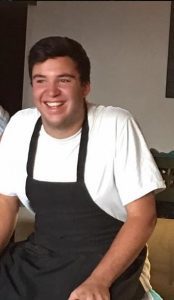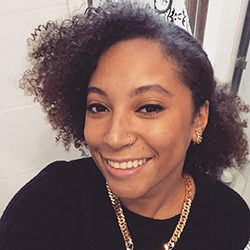Cuisine is a cultural fingerprint. Its nuances, uniqueness, and oddities are all irreplaceable signs of what is happening in the lives of the people who prepare each dish. In Toronto, Jamaican restaurants thrive just a few doors down from bustling Japanese Ramen spots. There are many examples of how different ethnic groups comfortably coexist in the city. A city’s restaurant scene is a reflection of its diverse populace; they are a symbol not only of who has arrived, but who has been empowered to thrive.
When the pioneers came over they adopted a lot of [Aboriginal] cooking styles and techniques to better serve themselves.
— Jake Tiggelman of Mississauga First Nation
When Canadian culinary institutions are put under that same lens, the story its curriculum tells is nothing like the one we glean walking around the city. While many schools have units on the history of cuisine in Canada, Indigenous foods are rarely explored at much length. What’s more, the French culinary tradition is considered the international standard of gastronomic excellence, giving way to curriculum that are Eurocentric by design.
That stalemate leaves chef-hopefuls like 22-year-old Jake Tiggelman of Mississauga First Nation torn between mastering the art of preparing bannock versus béchamel. He says he took it upon himself to use the assignments he was given while studying at Stratford Culinary School to explore his cultural cuisine whenever he could.
“It kind of surprised me,” said Tiggleman. “They don’t talk about Aboriginal influence on cooking in Canada. When the pioneers came over they adopted a lot of [Aboriginal] cooking styles and techniques to better serve themselves.”

Jake Tiggelman, Stratford Chef School Graduate
Chef Johl Whiteduck Ringuette, the owner of the Anishinaabe restaurant NishDish Marketeria in Toronto, says culinary students are “being taught the Eurocentric values of French cuisine”. When he hires cooks fresh from culinary school at his restaurant, Whiteduck Ringuette says that he often reteaches fundamental techniques like the proper way to cut vegetables. His method prioritizes waste reduction over achieving a certain aesthetic.
“You’re busy trying to cut in the specific way you’ve been taught to cut a pear,” muses Whiteduck Ringuette. “That pear doesn’t taste different no matter how you cut it, and you’re putting me out of business by cutting it like that.”
“It [European techniques] are also not the only way to do food,” he adds. “There are all kinds of societies that know how to cook their own food, and we’re ready to share it with you.”
Modifying curriculum
After doing a scan of culinary programs across Canada, Chef Wes Wilkinson at Ottawa’s Algonquin College conceptualised a solution to both recruit and retain more Indigenous students. In 2015, he launched the Indigenous Cook Apprenticeship program with a $239,000 grant from the provincial government.
The program invites chefs from a swath of Indigenous nations to lead classes that teach practical and historical lessons in Indigenous cuisine. To date, all the program’s participants have been Indigenous, though Wilkinson says it is open to anyone who is interested in learning.
“If we offer an environment that is Indigenized, with Indigenous profs and Indigenous curriculum, the data shows very clearly that graduation rates go up. Last year we had an intake of 17 students, and 16 graduated,” Wilkinson said.
Learning of Algonquin’s new program piqued the interest of Jennifer Nuvvijaq Nattuk, who traveled some 2,000 kilometers from her home in Iqualuit, Nunavut to take part in it.
“I have always been passionate about food,” says Nattuk. “Before I went to college, I taught myself about cooking and baking.” Once she left home, Nattuk gravitated towards working in kitchens. “I learned from the chefs that I used to work with in a mining camp when I was a dish washer,” she recalls.
In the program, Nattuk worked with meat like caribou, elk, moose, and rabbit – a far cry from a chicken supreme, but just the tip of the iceberg for some students. “Most of the things our chef taught us were simple and I’d already learnt from my former co-workers and at home,” says Nattuk. “I wish the school had taught us more.”
Piecing Together History
It isn’t only chefs from the immediate community who are interested in learning about what Indigenous nations traditionally cooked. Chef Wayne Morris at Boralia, a restaurant that serves modern takes on Canadian settler cuisine, remembers how difficult it was to find information on Indigenous foods when he was researching for Boralia’s menu. “A lot of that stuff just wasn’t recorded and the recipes are hard to find,” he says.
Meanwhile, NishDish has become a hub where different nations can collaborate on building a more centralized body of knowledge about traditional foods.
“This journey is about reclamation of my own identity, but it happens to be through food sovereignty,” Whiteduck Ringuette says. “We’re trying to bring back the traditional Anishinaabe diet. Communities from all different nations are coming to NishDish and bringing knowledge about the food. The other really incredible thing that people are bringing are ancestral Indigenous seeds that have been kept at each harvest for over 300 years sometimes.”
Last year, Whiteduck Ringuette decided to take food education into his own hands. Partnering with Native Child and Family Services (NCFS), he launched a youth culinary arts program called Ojibiikaan. The program revolves around a community garden in Ashbridge’s Bay, a scenic area on the waterfront east of Toronto. The garden is tended by young people at every step of the harvest process: from cutting back saplings and tall grass, to preparing the soil and picking the vegetables when they are in season.
“It’s like no other course,” says Whiteduck Ringuette. “The plants grew enormous and beautiful with the all the love from the elders, the ceremony, the youth — all the care giving that the garden got.”
For recent culinary school graduates like Tiggelman, the choice between gaining experience in mainstream kitchens or joining the ranks of an Indigenous-inspired kitchen can seem like a career choice that sets the future in stone. “I’m kind of at a crossroads right now,” Tiggelman says. “I’m not sure if I want to stay in the regular culinary world or move to just Indigenous cuisine.”
As Indigenous chefs empower the next generation through networks both in and outside of culinary institutions, students like Tiggelman, in time, could have a plethora of options for exploring – and professionally prospering – off of cooking Indigenous foods.

Nicole Edwards is a freelance journalist based in Toronto. Her favourite topics to explore are culture, health, and race.

